Financial Accounting Analysis of Goodwill & Expenses - Pewter Ltd
VerifiedAdded on 2023/06/06
|8
|1863
|92
Report
AI Summary
This report addresses accounting queries related to Pewter Ltd, a frozen and canned fishery product company, focusing on goodwill and expense accounting. It discusses the treatment of brand image as an intangible asset under AASB 138 and the accounting for expenses or contingent liabilities under AASB 137, particularly concerning activities related to environmental responsibility. The report details how expenses incurred to enhance brand value and goodwill can be capitalized as intangible assets if they provide economic benefits over time. It also explains the proper accounting treatment for contingent liabilities, emphasizing the importance of cost-benefit analysis and transparent financial reporting. An example is provided to illustrate how expenses can be capitalized and amortized based on the net present value of future benefits. The report concludes by stressing the need for periodic impairment reviews of intangible assets and adherence to financial accounting standards to ensure accurate and reliable financial reporting. Desklib provides access to similar solved assignments and study tools for students.
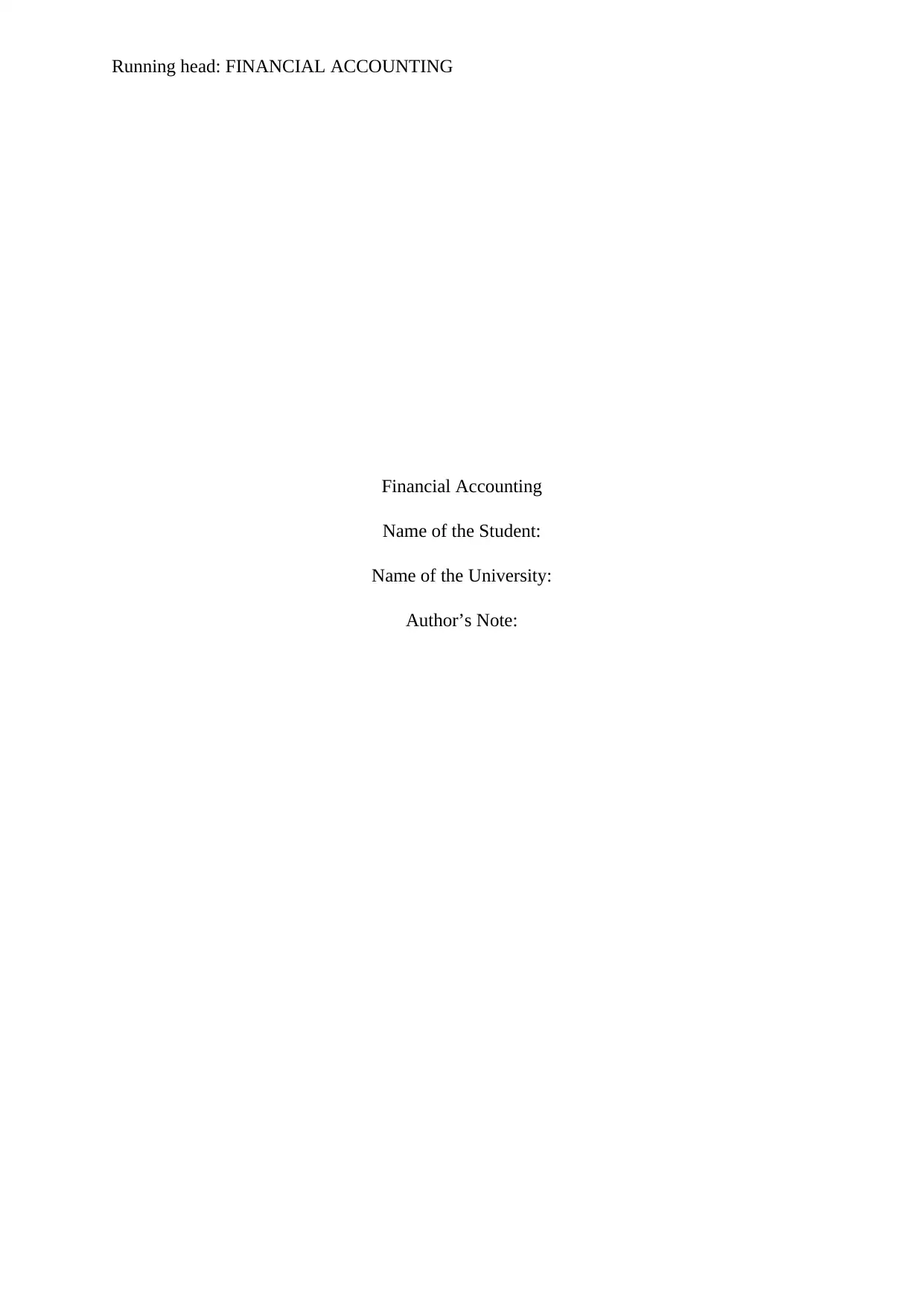
Running head: FINANCIAL ACCOUNTING
Financial Accounting
Name of the Student:
Name of the University:
Author’s Note:
Financial Accounting
Name of the Student:
Name of the University:
Author’s Note:
Paraphrase This Document
Need a fresh take? Get an instant paraphrase of this document with our AI Paraphraser
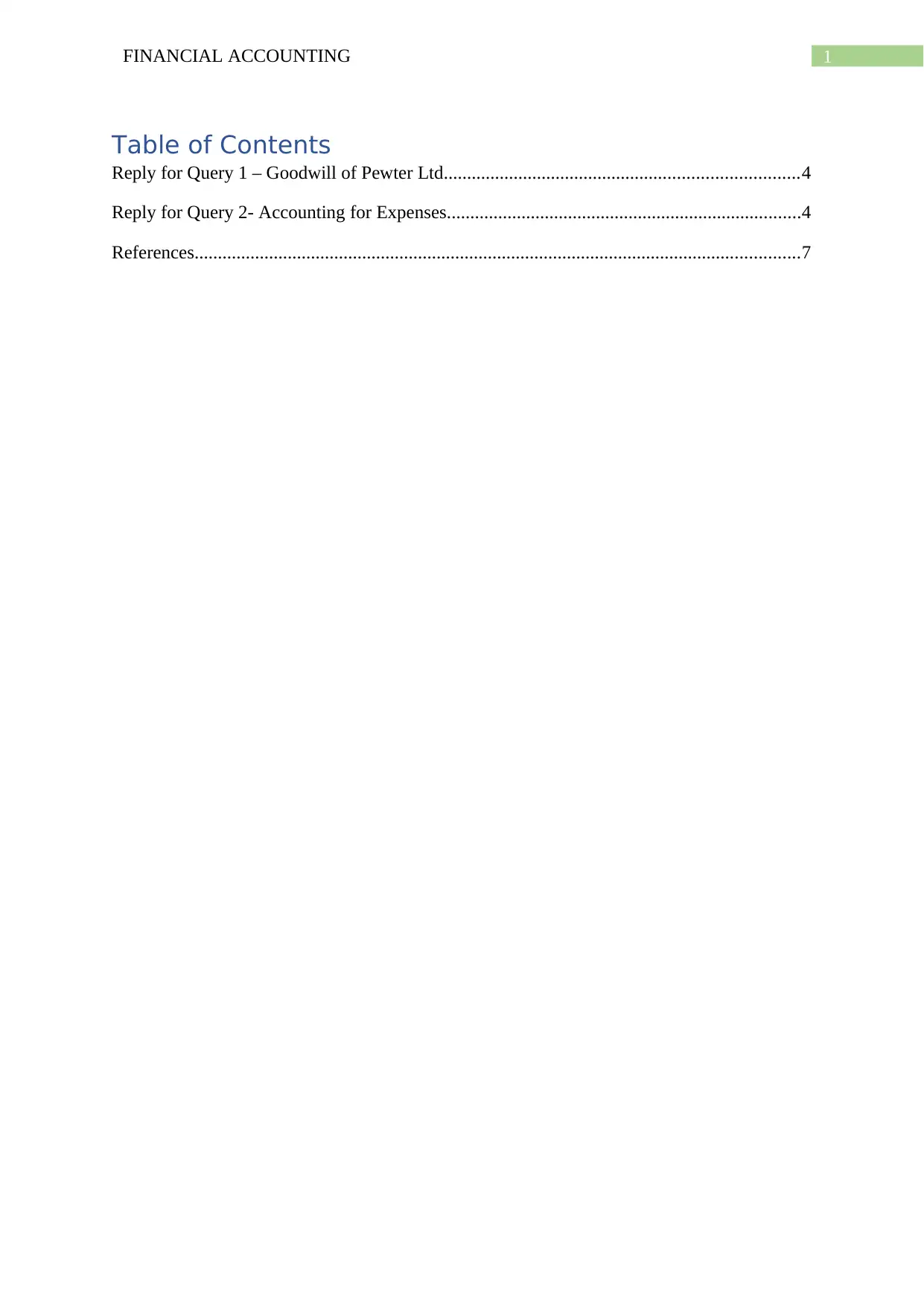
1FINANCIAL ACCOUNTING
Table of Contents
Reply for Query 1 – Goodwill of Pewter Ltd............................................................................4
Reply for Query 2- Accounting for Expenses............................................................................4
References..................................................................................................................................7
Table of Contents
Reply for Query 1 – Goodwill of Pewter Ltd............................................................................4
Reply for Query 2- Accounting for Expenses............................................................................4
References..................................................................................................................................7
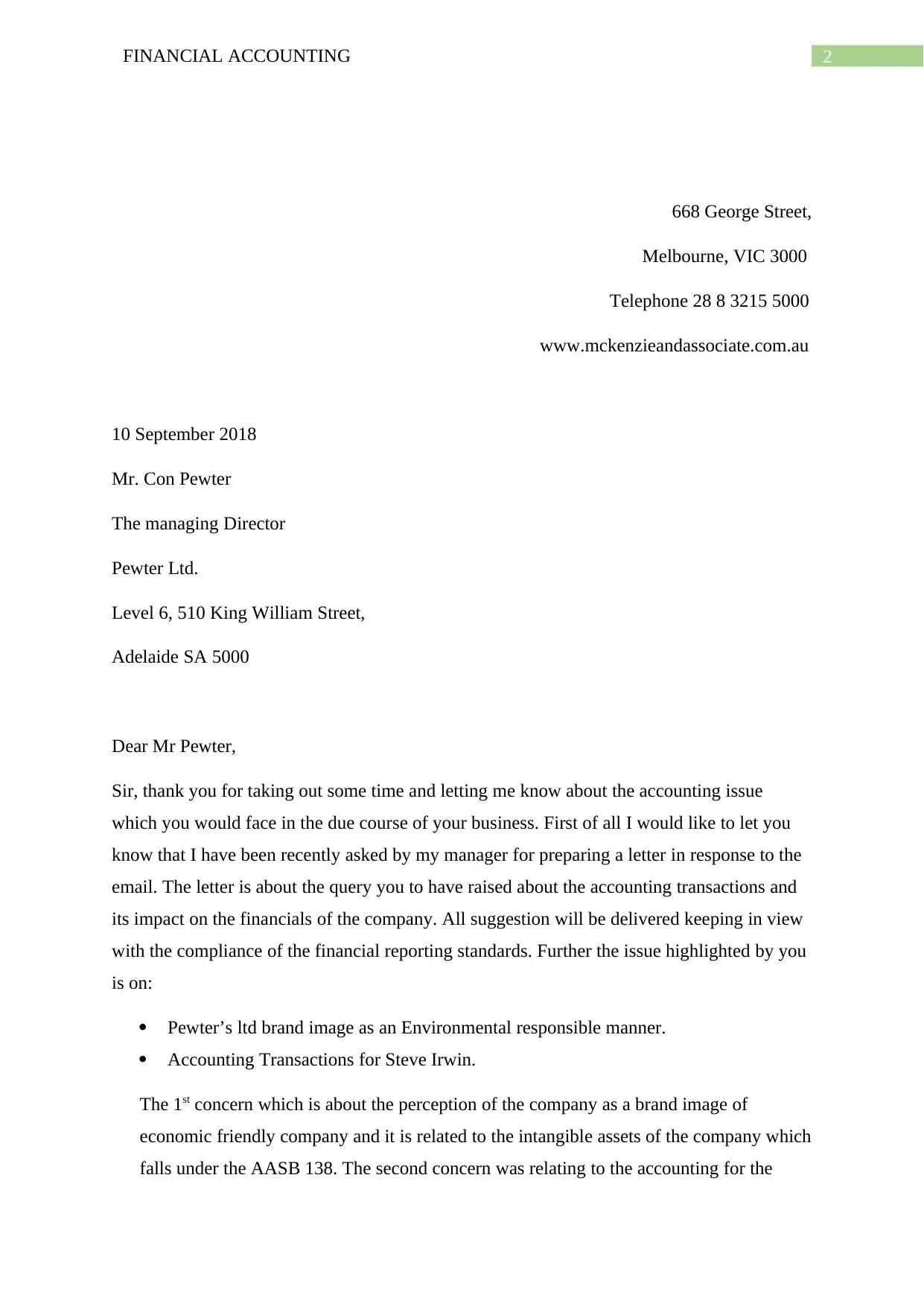
2FINANCIAL ACCOUNTING
668 George Street,
Melbourne, VIC 3000
Telephone 28 8 3215 5000
www.mckenzieandassociate.com.au
10 September 2018
Mr. Con Pewter
The managing Director
Pewter Ltd.
Level 6, 510 King William Street,
Adelaide SA 5000
Dear Mr Pewter,
Sir, thank you for taking out some time and letting me know about the accounting issue
which you would face in the due course of your business. First of all I would like to let you
know that I have been recently asked by my manager for preparing a letter in response to the
email. The letter is about the query you to have raised about the accounting transactions and
its impact on the financials of the company. All suggestion will be delivered keeping in view
with the compliance of the financial reporting standards. Further the issue highlighted by you
is on:
Pewter’s ltd brand image as an Environmental responsible manner.
Accounting Transactions for Steve Irwin.
The 1st concern which is about the perception of the company as a brand image of
economic friendly company and it is related to the intangible assets of the company which
falls under the AASB 138. The second concern was relating to the accounting for the
668 George Street,
Melbourne, VIC 3000
Telephone 28 8 3215 5000
www.mckenzieandassociate.com.au
10 September 2018
Mr. Con Pewter
The managing Director
Pewter Ltd.
Level 6, 510 King William Street,
Adelaide SA 5000
Dear Mr Pewter,
Sir, thank you for taking out some time and letting me know about the accounting issue
which you would face in the due course of your business. First of all I would like to let you
know that I have been recently asked by my manager for preparing a letter in response to the
email. The letter is about the query you to have raised about the accounting transactions and
its impact on the financials of the company. All suggestion will be delivered keeping in view
with the compliance of the financial reporting standards. Further the issue highlighted by you
is on:
Pewter’s ltd brand image as an Environmental responsible manner.
Accounting Transactions for Steve Irwin.
The 1st concern which is about the perception of the company as a brand image of
economic friendly company and it is related to the intangible assets of the company which
falls under the AASB 138. The second concern was relating to the accounting for the
⊘ This is a preview!⊘
Do you want full access?
Subscribe today to unlock all pages.

Trusted by 1+ million students worldwide
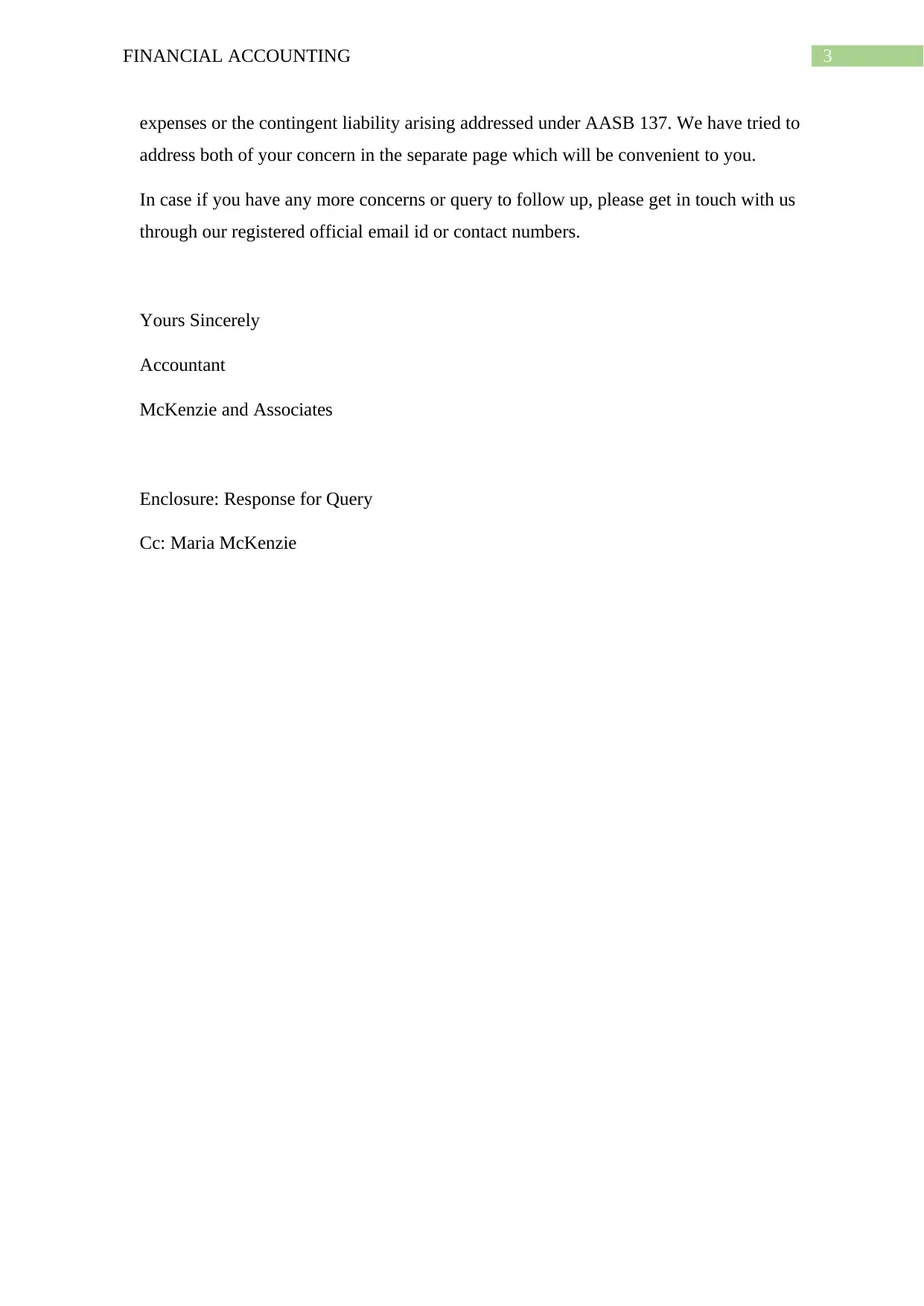
3FINANCIAL ACCOUNTING
expenses or the contingent liability arising addressed under AASB 137. We have tried to
address both of your concern in the separate page which will be convenient to you.
In case if you have any more concerns or query to follow up, please get in touch with us
through our registered official email id or contact numbers.
Yours Sincerely
Accountant
McKenzie and Associates
Enclosure: Response for Query
Cc: Maria McKenzie
expenses or the contingent liability arising addressed under AASB 137. We have tried to
address both of your concern in the separate page which will be convenient to you.
In case if you have any more concerns or query to follow up, please get in touch with us
through our registered official email id or contact numbers.
Yours Sincerely
Accountant
McKenzie and Associates
Enclosure: Response for Query
Cc: Maria McKenzie
Paraphrase This Document
Need a fresh take? Get an instant paraphrase of this document with our AI Paraphraser
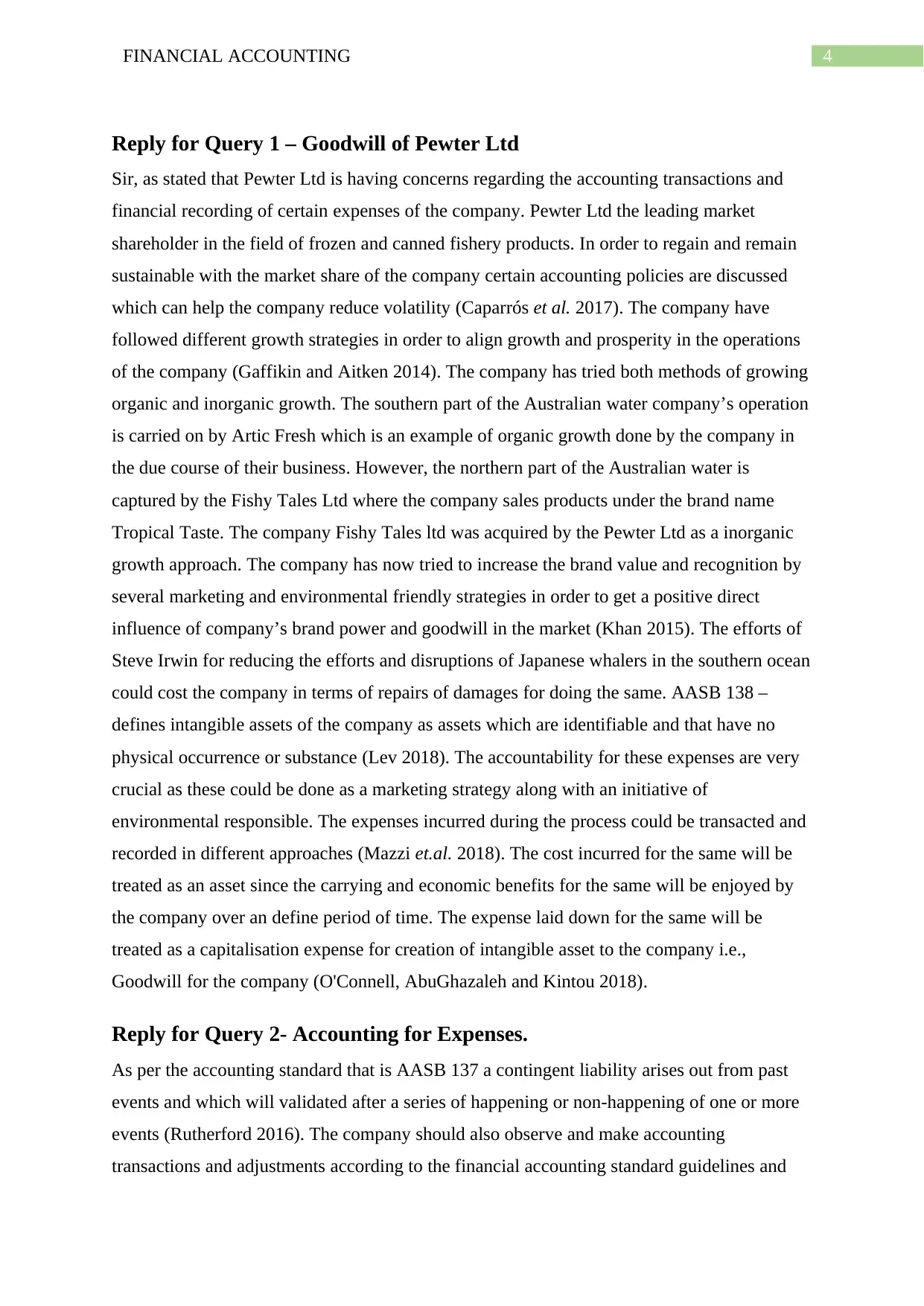
4FINANCIAL ACCOUNTING
Reply for Query 1 – Goodwill of Pewter Ltd
Sir, as stated that Pewter Ltd is having concerns regarding the accounting transactions and
financial recording of certain expenses of the company. Pewter Ltd the leading market
shareholder in the field of frozen and canned fishery products. In order to regain and remain
sustainable with the market share of the company certain accounting policies are discussed
which can help the company reduce volatility (Caparrós et al. 2017). The company have
followed different growth strategies in order to align growth and prosperity in the operations
of the company (Gaffikin and Aitken 2014). The company has tried both methods of growing
organic and inorganic growth. The southern part of the Australian water company’s operation
is carried on by Artic Fresh which is an example of organic growth done by the company in
the due course of their business. However, the northern part of the Australian water is
captured by the Fishy Tales Ltd where the company sales products under the brand name
Tropical Taste. The company Fishy Tales ltd was acquired by the Pewter Ltd as a inorganic
growth approach. The company has now tried to increase the brand value and recognition by
several marketing and environmental friendly strategies in order to get a positive direct
influence of company’s brand power and goodwill in the market (Khan 2015). The efforts of
Steve Irwin for reducing the efforts and disruptions of Japanese whalers in the southern ocean
could cost the company in terms of repairs of damages for doing the same. AASB 138 –
defines intangible assets of the company as assets which are identifiable and that have no
physical occurrence or substance (Lev 2018). The accountability for these expenses are very
crucial as these could be done as a marketing strategy along with an initiative of
environmental responsible. The expenses incurred during the process could be transacted and
recorded in different approaches (Mazzi et.al. 2018). The cost incurred for the same will be
treated as an asset since the carrying and economic benefits for the same will be enjoyed by
the company over an define period of time. The expense laid down for the same will be
treated as a capitalisation expense for creation of intangible asset to the company i.e.,
Goodwill for the company (O'Connell, AbuGhazaleh and Kintou 2018).
Reply for Query 2- Accounting for Expenses.
As per the accounting standard that is AASB 137 a contingent liability arises out from past
events and which will validated after a series of happening or non-happening of one or more
events (Rutherford 2016). The company should also observe and make accounting
transactions and adjustments according to the financial accounting standard guidelines and
Reply for Query 1 – Goodwill of Pewter Ltd
Sir, as stated that Pewter Ltd is having concerns regarding the accounting transactions and
financial recording of certain expenses of the company. Pewter Ltd the leading market
shareholder in the field of frozen and canned fishery products. In order to regain and remain
sustainable with the market share of the company certain accounting policies are discussed
which can help the company reduce volatility (Caparrós et al. 2017). The company have
followed different growth strategies in order to align growth and prosperity in the operations
of the company (Gaffikin and Aitken 2014). The company has tried both methods of growing
organic and inorganic growth. The southern part of the Australian water company’s operation
is carried on by Artic Fresh which is an example of organic growth done by the company in
the due course of their business. However, the northern part of the Australian water is
captured by the Fishy Tales Ltd where the company sales products under the brand name
Tropical Taste. The company Fishy Tales ltd was acquired by the Pewter Ltd as a inorganic
growth approach. The company has now tried to increase the brand value and recognition by
several marketing and environmental friendly strategies in order to get a positive direct
influence of company’s brand power and goodwill in the market (Khan 2015). The efforts of
Steve Irwin for reducing the efforts and disruptions of Japanese whalers in the southern ocean
could cost the company in terms of repairs of damages for doing the same. AASB 138 –
defines intangible assets of the company as assets which are identifiable and that have no
physical occurrence or substance (Lev 2018). The accountability for these expenses are very
crucial as these could be done as a marketing strategy along with an initiative of
environmental responsible. The expenses incurred during the process could be transacted and
recorded in different approaches (Mazzi et.al. 2018). The cost incurred for the same will be
treated as an asset since the carrying and economic benefits for the same will be enjoyed by
the company over an define period of time. The expense laid down for the same will be
treated as a capitalisation expense for creation of intangible asset to the company i.e.,
Goodwill for the company (O'Connell, AbuGhazaleh and Kintou 2018).
Reply for Query 2- Accounting for Expenses.
As per the accounting standard that is AASB 137 a contingent liability arises out from past
events and which will validated after a series of happening or non-happening of one or more
events (Rutherford 2016). The company should also observe and make accounting
transactions and adjustments according to the financial accounting standard guidelines and
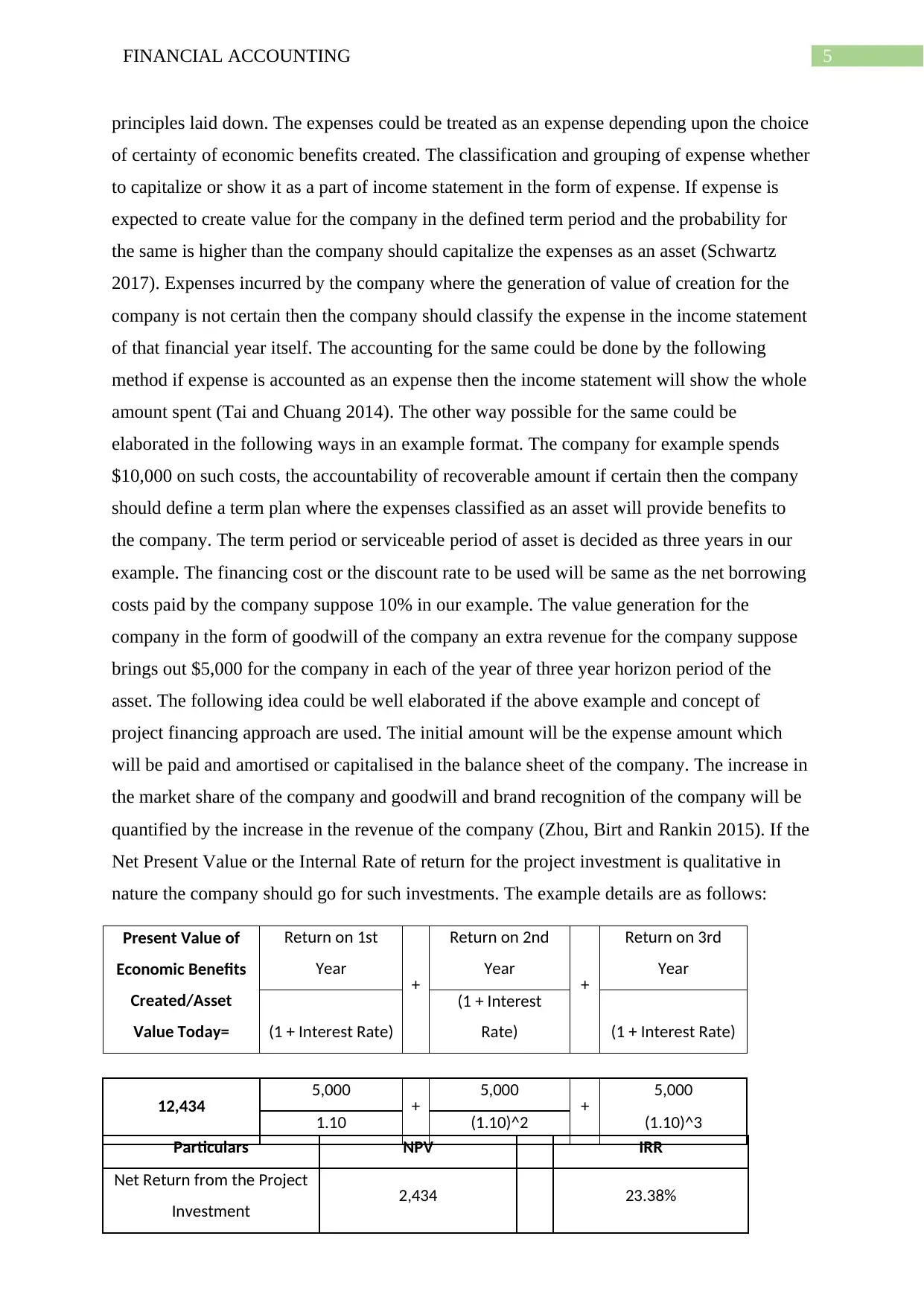
5FINANCIAL ACCOUNTING
principles laid down. The expenses could be treated as an expense depending upon the choice
of certainty of economic benefits created. The classification and grouping of expense whether
to capitalize or show it as a part of income statement in the form of expense. If expense is
expected to create value for the company in the defined term period and the probability for
the same is higher than the company should capitalize the expenses as an asset (Schwartz
2017). Expenses incurred by the company where the generation of value of creation for the
company is not certain then the company should classify the expense in the income statement
of that financial year itself. The accounting for the same could be done by the following
method if expense is accounted as an expense then the income statement will show the whole
amount spent (Tai and Chuang 2014). The other way possible for the same could be
elaborated in the following ways in an example format. The company for example spends
$10,000 on such costs, the accountability of recoverable amount if certain then the company
should define a term plan where the expenses classified as an asset will provide benefits to
the company. The term period or serviceable period of asset is decided as three years in our
example. The financing cost or the discount rate to be used will be same as the net borrowing
costs paid by the company suppose 10% in our example. The value generation for the
company in the form of goodwill of the company an extra revenue for the company suppose
brings out $5,000 for the company in each of the year of three year horizon period of the
asset. The following idea could be well elaborated if the above example and concept of
project financing approach are used. The initial amount will be the expense amount which
will be paid and amortised or capitalised in the balance sheet of the company. The increase in
the market share of the company and goodwill and brand recognition of the company will be
quantified by the increase in the revenue of the company (Zhou, Birt and Rankin 2015). If the
Net Present Value or the Internal Rate of return for the project investment is qualitative in
nature the company should go for such investments. The example details are as follows:
Present Value of
Economic Benefits
Created/Asset
Value Today=
Return on 1st
Year +
Return on 2nd
Year +
Return on 3rd
Year
(1 + Interest Rate)
(1 + Interest
Rate) (1 + Interest Rate)
12,434 5,000 + 5,000 + 5,000
1.10 (1.10)^2 (1.10)^3
Particulars NPV IRR
Net Return from the Project
Investment 2,434 23.38%
principles laid down. The expenses could be treated as an expense depending upon the choice
of certainty of economic benefits created. The classification and grouping of expense whether
to capitalize or show it as a part of income statement in the form of expense. If expense is
expected to create value for the company in the defined term period and the probability for
the same is higher than the company should capitalize the expenses as an asset (Schwartz
2017). Expenses incurred by the company where the generation of value of creation for the
company is not certain then the company should classify the expense in the income statement
of that financial year itself. The accounting for the same could be done by the following
method if expense is accounted as an expense then the income statement will show the whole
amount spent (Tai and Chuang 2014). The other way possible for the same could be
elaborated in the following ways in an example format. The company for example spends
$10,000 on such costs, the accountability of recoverable amount if certain then the company
should define a term plan where the expenses classified as an asset will provide benefits to
the company. The term period or serviceable period of asset is decided as three years in our
example. The financing cost or the discount rate to be used will be same as the net borrowing
costs paid by the company suppose 10% in our example. The value generation for the
company in the form of goodwill of the company an extra revenue for the company suppose
brings out $5,000 for the company in each of the year of three year horizon period of the
asset. The following idea could be well elaborated if the above example and concept of
project financing approach are used. The initial amount will be the expense amount which
will be paid and amortised or capitalised in the balance sheet of the company. The increase in
the market share of the company and goodwill and brand recognition of the company will be
quantified by the increase in the revenue of the company (Zhou, Birt and Rankin 2015). If the
Net Present Value or the Internal Rate of return for the project investment is qualitative in
nature the company should go for such investments. The example details are as follows:
Present Value of
Economic Benefits
Created/Asset
Value Today=
Return on 1st
Year +
Return on 2nd
Year +
Return on 3rd
Year
(1 + Interest Rate)
(1 + Interest
Rate) (1 + Interest Rate)
12,434 5,000 + 5,000 + 5,000
1.10 (1.10)^2 (1.10)^3
Particulars NPV IRR
Net Return from the Project
Investment 2,434 23.38%
⊘ This is a preview!⊘
Do you want full access?
Subscribe today to unlock all pages.

Trusted by 1+ million students worldwide

6FINANCIAL ACCOUNTING
Every investment should be done on cost benefit analysis for the company. The accounting
procedure along with the accounting transaction and nature should be clearly represented in a
transparent form. The key accounting decision also lies with the management of the company
for the judgemental analysis of the same. The company should also oversight the intangible
assets of the company and periodical review of the same would be done to see if the asset
value for producing the return is efficient or not. Periodical Impairment and review of
Intangible assets of the company could turn out the fair value of the assets. As an act for
Corporate Social Responsibility the company should deliver back and not degrade the
resources it uses, exploitation of these resources could affect and influence the operations and
margins of the company. The audit committee should periodically review these assets and
should be subject to impairment. However it should also be noted that the company’s
initiative for the same will directly have a positive influence on the company financial reports
and growth. The financial accounting standards and guidelines must govern all accounting
transaction done in order to avoid conflict of interest.
Every investment should be done on cost benefit analysis for the company. The accounting
procedure along with the accounting transaction and nature should be clearly represented in a
transparent form. The key accounting decision also lies with the management of the company
for the judgemental analysis of the same. The company should also oversight the intangible
assets of the company and periodical review of the same would be done to see if the asset
value for producing the return is efficient or not. Periodical Impairment and review of
Intangible assets of the company could turn out the fair value of the assets. As an act for
Corporate Social Responsibility the company should deliver back and not degrade the
resources it uses, exploitation of these resources could affect and influence the operations and
margins of the company. The audit committee should periodically review these assets and
should be subject to impairment. However it should also be noted that the company’s
initiative for the same will directly have a positive influence on the company financial reports
and growth. The financial accounting standards and guidelines must govern all accounting
transaction done in order to avoid conflict of interest.
Paraphrase This Document
Need a fresh take? Get an instant paraphrase of this document with our AI Paraphraser

7FINANCIAL ACCOUNTING
References
Caparrós, A., Oviedo, J.L., Álvarez, A. and Campos, P., 2017. Simulated exchange values
and ecosystem accounting: Theory and application to free access recreation. Ecological
Economics, 139, pp.140-149.
Gaffikin, M. and Aitken, M. eds., 2014. The Development of Accounting Theory (RLE
Accounting): Significant Contributors to Accounting Thought in the 20th Century. Routledge.
Khan, M., 2015. Accounting: Financial. In Encyclopedia of Public Administration and Public
Policy, Third Edition-5 Volume Set (pp. 1-6). Routledge.
Lev, B., 2018. The deteriorating usefulness of financial report information and how to reverse
it. Accounting and Business Research, 48(5), pp.465-493.
Mazzi, F., Slack, R., Tsalavoutas, I. and Tsoligkas, F., 2018. Country Level Corruption and
Accounting Choice: Research & Development Capitalization Under IFRS.
O'Connell, V., AbuGhazaleh, N. and Kintou, A., 2018. The impact of R&D programme
success on the decision to capitalise development expenditures in European
firms. Technology Analysis & Strategic Management, 30(1), pp.15-30.
Rutherford, B.A., 2016. Articulating accounting principles: Classical accounting theory as the
pursuit of “explanation by embodiment”. Journal of Applied Accounting Research, 17(2),
pp.118-135.
Schwartz, M.S., 2017. Corporate social responsibility. Routledge.
Tai, F.M. and Chuang, S.H., 2014. Corporate social responsibility. Ibusiness, 6(03), p.117.
Zhou, T., Birt, J. and Rankin, M., 2015. The value relevance of exploration and evaluation
expenditures. Accounting Research Journal, 28(3), pp.228-250.
References
Caparrós, A., Oviedo, J.L., Álvarez, A. and Campos, P., 2017. Simulated exchange values
and ecosystem accounting: Theory and application to free access recreation. Ecological
Economics, 139, pp.140-149.
Gaffikin, M. and Aitken, M. eds., 2014. The Development of Accounting Theory (RLE
Accounting): Significant Contributors to Accounting Thought in the 20th Century. Routledge.
Khan, M., 2015. Accounting: Financial. In Encyclopedia of Public Administration and Public
Policy, Third Edition-5 Volume Set (pp. 1-6). Routledge.
Lev, B., 2018. The deteriorating usefulness of financial report information and how to reverse
it. Accounting and Business Research, 48(5), pp.465-493.
Mazzi, F., Slack, R., Tsalavoutas, I. and Tsoligkas, F., 2018. Country Level Corruption and
Accounting Choice: Research & Development Capitalization Under IFRS.
O'Connell, V., AbuGhazaleh, N. and Kintou, A., 2018. The impact of R&D programme
success on the decision to capitalise development expenditures in European
firms. Technology Analysis & Strategic Management, 30(1), pp.15-30.
Rutherford, B.A., 2016. Articulating accounting principles: Classical accounting theory as the
pursuit of “explanation by embodiment”. Journal of Applied Accounting Research, 17(2),
pp.118-135.
Schwartz, M.S., 2017. Corporate social responsibility. Routledge.
Tai, F.M. and Chuang, S.H., 2014. Corporate social responsibility. Ibusiness, 6(03), p.117.
Zhou, T., Birt, J. and Rankin, M., 2015. The value relevance of exploration and evaluation
expenditures. Accounting Research Journal, 28(3), pp.228-250.
1 out of 8
Related Documents
Your All-in-One AI-Powered Toolkit for Academic Success.
+13062052269
info@desklib.com
Available 24*7 on WhatsApp / Email
![[object Object]](/_next/static/media/star-bottom.7253800d.svg)
Unlock your academic potential
Copyright © 2020–2026 A2Z Services. All Rights Reserved. Developed and managed by ZUCOL.





